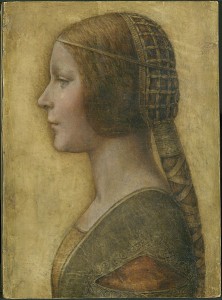
La Bella Principessa: Da Vinci would be proud, if he in fact created it.
La Bella Principessa is a painting worth somewhere between $19,000 and $150 million dollars. In 1998, Christie’s listed the chalk-and-ink drawing on vellum dated as early 19th century and Germanic in provenance. (Oops!) It was sold to Kate Ganz for $21,850. The portrait was sold a few years later to Peter Silverman for a similar amount. The portrait is turning out to be a good investment that, actually, dates back to the Renaissance and was executed during the 1490s. According to many (though not all) experts, the painting is a portrait by Leonardo Da Vinci worth $150 million. If La Bella Principessa (or, Portrait of a Young Fiancee) is in fact a Da Vinci, it would represent the first new work by Da Vinci discovered in more than 75 years.
A diamond is forever, according to the De Beers diamond cartel. It is among the hardest naturally occurring materials known, and has the highest thermal conductivity. And thanks to a couple of startups, diamonds are also becoming (relatively) affordable. In Florida, Gemesis uses high temperature and high pressure to create “cultured” diamonds in a chamber that mimics geologic conditions. In Boston, Apollo Diamond uses chemical vapor deposition to create diamonds that would be indistinguishable from natural diamonds. Welcome to the age of gem-quality manufactured diamonds.
There were some compelling archaeological finds last year: Stonehenge turns out to be part of a much broader Neolithic ceremonial landscape, with thousands of new archaeological features spread across almost five square miles; the Canadian Prime Minister announced that the HMS Erebus had been discovered after decades spent searching; funerary wrappings proved that the Egyptians were mummifying their dead 1,500 years earlier than we previously thought; the Seaton Down Hoard involves one of the largest Roman coin hoards ever found. No notable archaeological fakes made headlines in 2014, but here is a list of 10 fake archaeological finds from previous years, which includes a (fake) tiara, the “oldest” (fake) star map, and even a (fake) Persian princess.
Hans-Jurgen Kuhl is a printmaker and artist from Germany. He was known as “the Dove” and was once dubbed “the Warhol of Cologne.” During the 60s he had a career designing leather hot pants and then high-end Warhol knockoff prints during the early 80s. He eventually developed his own manufacturing process that combined offset printing with silk-screening to print $100 bills. He is considered the “ultimate counterfeiter” whose bills were described as shockingly perfect.
During Medieval times, professional mourners were hired for funerals; because they were being paid, their emotions were regarded as insincere—such people were called “placebos.” The word “placebo” tends to have a negative connotation, which is ironic given that the word comes from the Latin for “I will please.” More recently, a “placebo” refers to a sugar pill or inert substance given instead of medication. There is an inherent element of deception involved in administering a placebo instead of a medication proven to be effective. Yet somehow, the placebo itself can be an effective form of treatment. Neuroimaging has shown evidence of a placebo effect and a nocebo effect. Instead of being considered worthless, placebos are being investigated as an effective method for healing and treating pain and illness.
